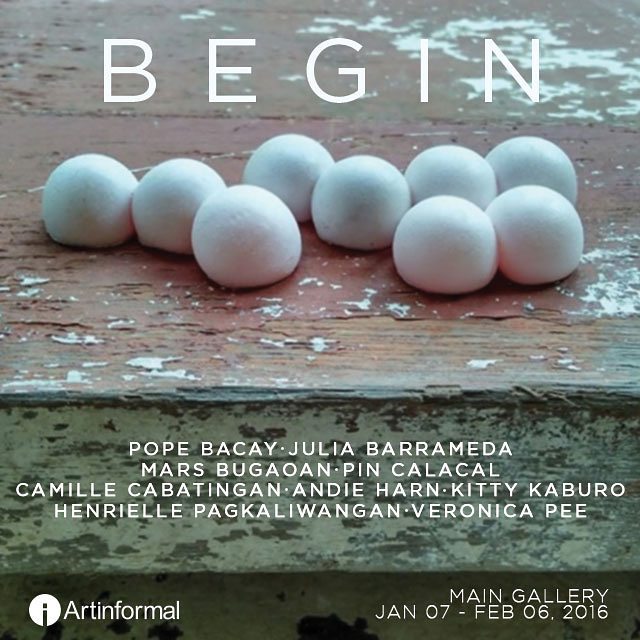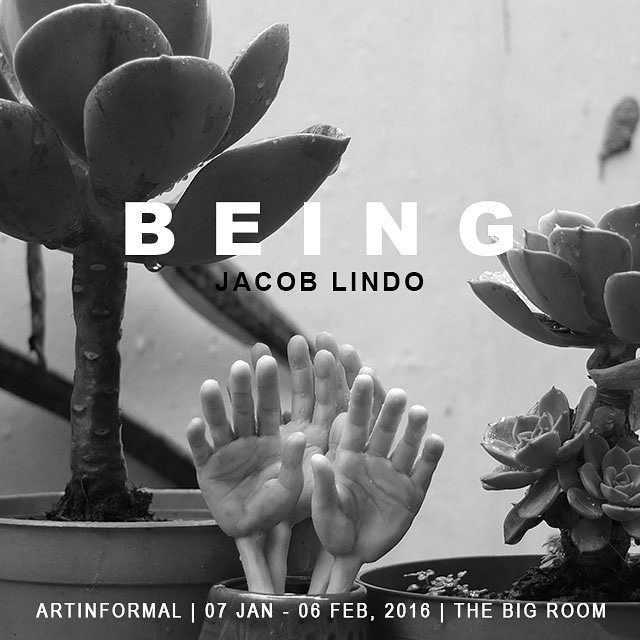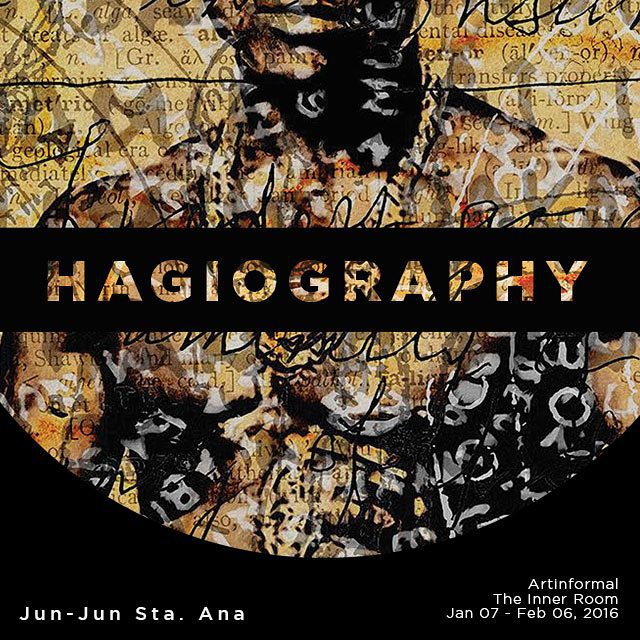Group Show: Begin, Jacob Lindo, Jun-Jun Sta. Ana
Thursday, January 7, 2016
at 6 PM
Artinformal
277 Connecticut St. Greenhills East, Mandaluyong, Philippines

Main Gallery
BEGIN | Group Show
Pope Bacay
Julia Barrameda
Mars Bugaoan
Pin Calacal
Camille Cabatingan
Andie Harn
Kitty Kaburo
Henrielle Pagkaliwangan
Veronica Pee
Beginnings speak of blank and clean slates, an openness to possibility. It is renewal, the sliver of light in the midst of chaos. It is about change, of additions, removals and ends. It points to chances for the mundane and the fantastical. It is time, a confrontation of memories, histories and futures.
This 2016, Artinformal welcomes this new chapter with a group exhibition by nine young artists treading the various personal and impersonal geographies of beginnings. Aptly titled “Begin”, this is a collection of narratives, continuously being written and re-written to manifest their individual shifts and progressions.
Pope Bacay and Kitty Kaburo reimagines environments and landscapes through experimentations of layers, renditions and processes. In the same line, Mars Bugaoan breathes life onto old photographs through erasures and scratches which are, at the same time, stitched back together. Veronica Pee continues her exploration of the moon, while presenting alongside it an installation of the early stages of construction. On the other hand, Julia Barrameda and Henrielle Pagkaliwangan chronicles the ephemerality of experiences, through etching fleeting moments in video and on acrylic sheets, and through a meticulously diaristic view of the everyday respectively. Pin Calacal’s use of hair highlights the tension between new life and intimate bonds formed from dead and loose strands. Andie Harn fabricates a memorial quilt, stained with her classmates’ hard work, mistakes and celebrations in their pursuit of becoming artists, while Camille Cabatingan morphs fossilized creatures to comment on animal cruelty as taught in the Biblical teachings of man’s role towards nature.
Although unique and thoroughly different, there is a thin yet visible line running through each of the works. Coinciding with the emergence of this new year, this is a gathering of fresh eyes and new perspectives of what it means to begin again.
by Iris Ferrer

Big Room
BEING | Jacob Lindo
If things are going to be simplified, all the complexities of life’s in-betweens, the maybes, the probablys, the would-do-buts, and all other hesitations, if they are going to be tossed out even temporarily from our lives, life would basically be a choice of black and white. A toss coin, a game of chance at some time, a hard yes or no. But Life is a deviser of great machination that leaves us waltzing along with it making us confused, nauseated, aggressive or simply just resigned. She’d give away a small secret of hers which would spawn a whole dozen of secrets.
Since Life is so schemed in giving herself, we humans learned to adapt with it. Because of this, we evolved into social beings, biologically wired to interact with other people to find social belonging and to survive the harsh terrains of life. We communicate daily and express our feelings verbally or through gestures. Various social media are even created, a complete evidence that we are genetically a collective being that needs to socialize. But what do we really understand about others? Has this “need to communicate” made us empathetic or are we just blankly scrolling past each other?
In “Being”, Jacob Lindo’s sculptures stands on the plane of finite existence huddled in mystery. At first glance the figures that will catch the eye looks like just a distorted mess. It does not resemble any living thing. But upon examining the things closely some parts are almost human. It got an armless over-weight body, a hand on a head and a dark, flat complexion. The figures seem to be discussing through the gestures of the hand-heads. According to Lindo, these eerie unearthly things are a reflection of us as individuals and how we navigate our way into society. The sculptures are arranged in such a way that they are interacting with each other, their gestures diced into the most fundamental and intelligible “no” and “yes” hand signs which represents each individual fizzing on different views or biases. The bodies of the figures are somewhat over-weight in comparison to a standard normal physique, a metaphor for the self-gratifying nature of a man knowing or unknowingly for survival or for the pursuit of pleasure. The artist also see us as tiny points interacting, agreeing or sometimes rejecting the views of each other, atoms bumping to each other, making our way into the grand scheme of things and the manner of our motion into the environment we live in is always determined by our choices.
by Shalimar Gonzaga

Inner Room
HAGIOGRAPHY | Jun-Jun Sta. Ana
Portraiture, by oneself or of others, rises indefatigably in tandem with social media in which we are signified and identified by our profile photos. More often than not, they are carefully crafted images that show our best light, chosen for the purpose of being seen, our faces set against things and ideas that reflect our perceived personal, economic and social states or aspirations. Not the least innocent and impartial, they are instruments of self-presentation.
In Jun-Jun Sta. Ana’s Hagiography, the faces that we see are from the dating (or, more accurately, hook-up) app for gay men called Grindr. It is in the dating sites like this where the awareness of the viewing “other” reaches fever-pitch intensity, requiring, on the part of the user, great imaginative leaps in his orchestration of the details of his profile photo that would make him appear, in one quick glance or scroll, that he is sexually attractive and viable. The profile photo becomes, at once, a lure and an invitation.
Rather than interrogate or deflate the notion of identity evoked in these portraits, Sta. Ana holds these subjects true to their attempts, from solemn to bold, at self-reinvention, complicating their images with layers of text, graphic design and free-hand illustration (Sta. Ana’s oracion motif is also present here), tattooing onto their skins and faces words and objects that disrupt any close reading of the figures’ gestures and the original purpose of their aims, i.e., to seduce.
While we do detect attractive features (the smoldering gaze, the raging musculature, the Adonis belt), we are drawn to the inscription that imbues the figures with significance as conveyors of meaning and arcane knowledge, not unlike those in illuminated manuscripts. In most cases, the inscription is more pictorial than linguistic, creating all sorts of patterns and arrangements, emanating from the bodies of the subjects, blurring the distance between foreground and background. In their “flattened” state, the works seem to be illustrative—and instructive—of impossible yearnings and desires.
As such, Sta. Ana doesn’t attempt to capture any essentialist notion of self—as how a usual portraitist would avow—but instead offers us faces and bodies thick with history, teeming with alternative lives and arbitrary meanings. They may have objectified themselves at the onset with these portraits but Sta. Ana subjectifies them and by subjectifying them offers the possibility of release from a singular, imprisoning representation. One can’t think of these works as anything but tributes, imbued, as it were, with a fervent, almost spiritual incandescence. Curiously, in one of the portraits, a telling word resides amid the gamut of other words: “hagiography,” the term used for the biography of saints.
by Carlomar Arcangel Daoana
Invite:
https://www.facebook.com/events/164337997261703
